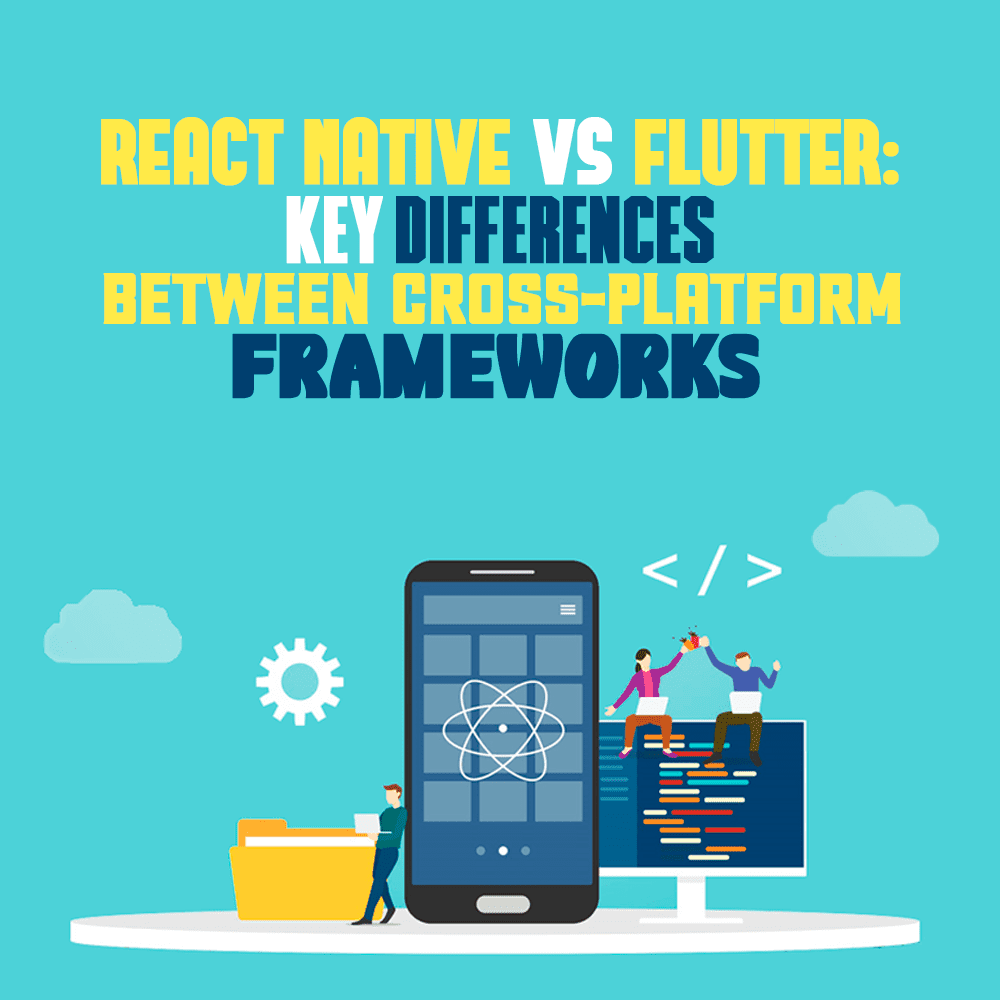
As a result, today most of us have Android or iPhones with hundreds of apps in them, which are not even 1% of the total Android or iPhone app market. That also means hundreds of apps are being released on Google Play and App Store daily, and this number continues to grow.
Nowadays, having their own mobile apps has become a necessity for businesses wanting to flourish—especially in the IT and tech industry. Consequently, mobile app development businesses have seen a surge in demand.
And so, knowing the importance of having a mobile application for your business, you have to pick a technology that is worth your investment, effort, and most of all time. What is it going to be? Flutter or React Native (RN)?
Keep on reading to find out about these two cross-platform app development frameworks, their features and key differences, and you will have your answer shortly.
React Native
React Native is perhaps the most renowned cross-platform framework that uses JavaScript. It was developed by social media giant Meta (earlier known as Facebook) using a mixture of JavaScript and XML (Esque markup), which is known as JSX.
It is primarily focused on the native rendering of apps that allow you to create applications for iOS and Android both with a single code base. Popular apps such as Facebook, Instagram, Pinterest, Tesla, Bloomberg, Skype, Facebook Ad Manager, and Wix are powered up by it.
Pros of React Native
With this in mind, let’s take a look at the best advantages of React Native.
- One team is enough to pull off the job. Yes! You read it right. React Native is known to be run on Android and iOS both without having to worry about learning a separate programming language. That means a single codebase is enough to run apps on both iOS and Android platforms.
- Fast refresh rate. Apps developed using React Native perform better. The development process is faster and the developer sees local changes without rebuilding the native application. Plus, you don’t have to worry about losing data due to Hot Reload, as it also retains the app’s state to speed up the process and productivity even further.
- Simplified user interface (UI). React Native is based on JS (JavaScript) which enhances the app designing experience and simplifies the app’s interface. This means time savings—as JS makes it perform faster with minimal application load time and increased productivity—and an overall better user experience.
- Best in the industry. React Native enjoys a large community of mobile app development contributors — as Facebook released React Native in 2015 and adds useful components from time to time that really smoothes the entire operation of developing an app.
- Cost efficiency. The app development cost using React Native is much lower. Why? Because there is no need to hire two individual teams for your Android or iOS app development project. One team is sufficient to deliver for both platforms.
Cons of React Native
Bearing all the aforementioned pros in mind, now let’s move on to some of its cons. Here I’ve listed drawbacks you should know about before opting for it.
- Designing the code is not easy. Though RN uses JS, that doesn’t necessarily mean one experienced in JS can pull off the job. Knowledge of Native and good exposure to React Native is needed to get the desired results. Therefore, businesses should take this into consideration and pick the right one for their needs.
- Debugging is challenging. Debugging an RN app is challenging and pretty tedious. It may invite some unwelcome bugs during the process as well. Therefore, you need to hire an expert that has not only sound knowledge of Java/JavaScript but is also well-versed with various debugging integration tools, such as Flipper.
Overall, however, React Native stands out among the various other mobile application development software, making the job easier than ever before.
Flutter

Unlike React Native, Flutter uses Dart—another programming language developed by Google—to let mobile app developers design beautiful natively compiled applications from a single codebase.
Flutter consists of two important parts you should know about:
- Software Development Kit (SDK): In short, SDK is a collection of various tools that help developers to create apps for mobile devices by compiling the code into the native one.
- A framework: It is nothing but a collection of UI-based libraries of widgets, developed to simplify the user experience even better. For example, sliders, interactive buttons, spaces to input text, and so forth. This helps you to personalize your app as per your needs.
Pros of Flutter
As I did with React Native, I will also offer you a list of the pros and cons of Flutter, starting with the former.
- Quick development. Flutter is also a cross-platform mobile app development language. That means an app is required to be built only once and that will work on both iOS and Android. However, there could be a couple of changes in a few lines of code when the app is being developed for iOS specifically.
- Impressive UI. Flutter is pumped up with Skia—an open-source performance booster engine that provides high graphics. Chrome, Amazon’s Kindle, and Adobe are great examples of Skia. No matter how complex the app is, using Skia, you can always change or customize the user interface (UI) as per your requirement.
- Easy compilation and live reload. Flutter allows the developers to change, edit, delete, modify, and create the code right from the beginning to compilation. Apart from that, ‘Hot Reload’ saves time by allowing programmers to test the codes in real time.
- Everything at one place. Flutter combines maximum results with minimal cost. This amazingly built SDK offers several features in a single application suite. Whatever you need, be it widgets, interactive designs, or multi-functions, everything is at your disposal at a low cost.
Cons of Flutter
Despite its great features, Flutter does come with some drawbacks you should know about.
- Lacks support of third-party libraries. Flutter offers a wider range of libraries but within a very limited number as compared to other cross-platform app development programs. So if you are someone who dreams of developing a multi-featured app, Flutter won’t be the right choice for you.
- Bulky app size. Generally, apps released via Flutter are heavy and eat up memory. This might lead to fewer daily active users on your app. Eventually, your rival gets the opportunity to beat you and wins the race. If you are a small business or a startup that wishes to hold the flag, it would be wise for you to avoid Flutter at first.
- Uneasy to digest for iOS. Developers face challenges with apps on iOS platforms. For example, when an Apple phone takes a picture, files containing the EXIF extension get deleted afterward. Moreover, features like VoiceOver, Audio Description, Captioning, and Guided Access are practically impossible to sync with Flutter at present.
- Freezes while using multiple gestures. If your app has to offer unique features such as multiple screen interactions, transitions, and multi-touches, then Flutter might not be the one you’re looking for. Although it is capable of empowering complex apps, multiple gestures are something it is not comfortable with.
- Duh… It’s all about Dart again. Dart is fast but often loses the race against giants such as C#, Objective C, and JS. Consequently, professional programmers generally opt for other languages, which makes finding a Dart expert a real challenge. And if you could find one, you might not receive the after-support as per your expectation.
Key Differences Between Facebook’s React Native and Google’s Flutter
Now that you have a clear understanding of both these cross-platform mobile app development frameworks—along with their advantages and shortcomings—it’s time we march towards and dive into their key differences.
Origin
React Native is one of the great creations of Facebook. It is widely used to create dynamic apps. Flutter was launched in 2017—after two years of RN release—and is a product of Google. It ranks second after Reactive Native.
Programming Style
First of all, RN (React Native) is an enhanced version of React, written in JSX—that is JavaScript XML. It is easier for programmers to build applications using it.
On the other hand, Flutter’s codebase is based on the Dart programming language, which is a whole new domain for many developers and has not been used that much. However, both frameworks stick to OOPs (Object-oriented programming) and their syntax is C-based.
Performance
Fortunately, both frameworks are open-source, free to use, and their repositories are well-maintained—which is quite obvious as their originators are renowned tech tycoons.
Google’s Flutter can create almost all sorts of apps using its built-in iOS lookalike material designs and style, but not as impressive or rich as native ones. On the other hand, apps made with React Native are quite handy to deal with large-scale as well as MVP (minimum viable products).
Flutter has a great advantage over RN in terms of app testing. Applications built using it reduce the time of testing up to 50% whereas, in the case of React Native, developers need to run a thorough test before okaying it for end-use.
In a nutshell, both platforms seem to be delivering well-performing applications, but if a prototype or large-scale project is involved, one should definitely give a try to React Native due to the potential it carries.
Community Support
React Native is blessed with a large community of developers and various community forums with over 50k daily active users across the internet. These people provide support and ensure the flawless development of apps by mitigating potential errors/bugs. Updates and latest releases are also entertainable there.
Flutter is on the rise and enjoys external support via communities but lacks in terms of a wider reach. There are only a handful of people for Flutter compared to RN.
Futuristic Technology

React Native is beyond the odds now and fully capable of delivering high-tech, future-oriented mobile apps.
Flutter is the new player in the market and looks promising as well, but it still has to win people’s trust, considering the number of stability concerns that have been reported on internet forums.
And the Winner Is …
It is amazing to see the surge in Flutter’s demand in just a few years after its launch, yet it is less than React Native in many aspects—and there is no doubt in saying that.
Several mobile app developers, SMEs, and startups have found success with React Native. All just because of its tons of unique features, capabilities, ease of use, and performance it facilitates people with.
So if I have to pick a technology that is worth my investment, effort, and most of all could generate revenue in a short time, I would go with React Native.
